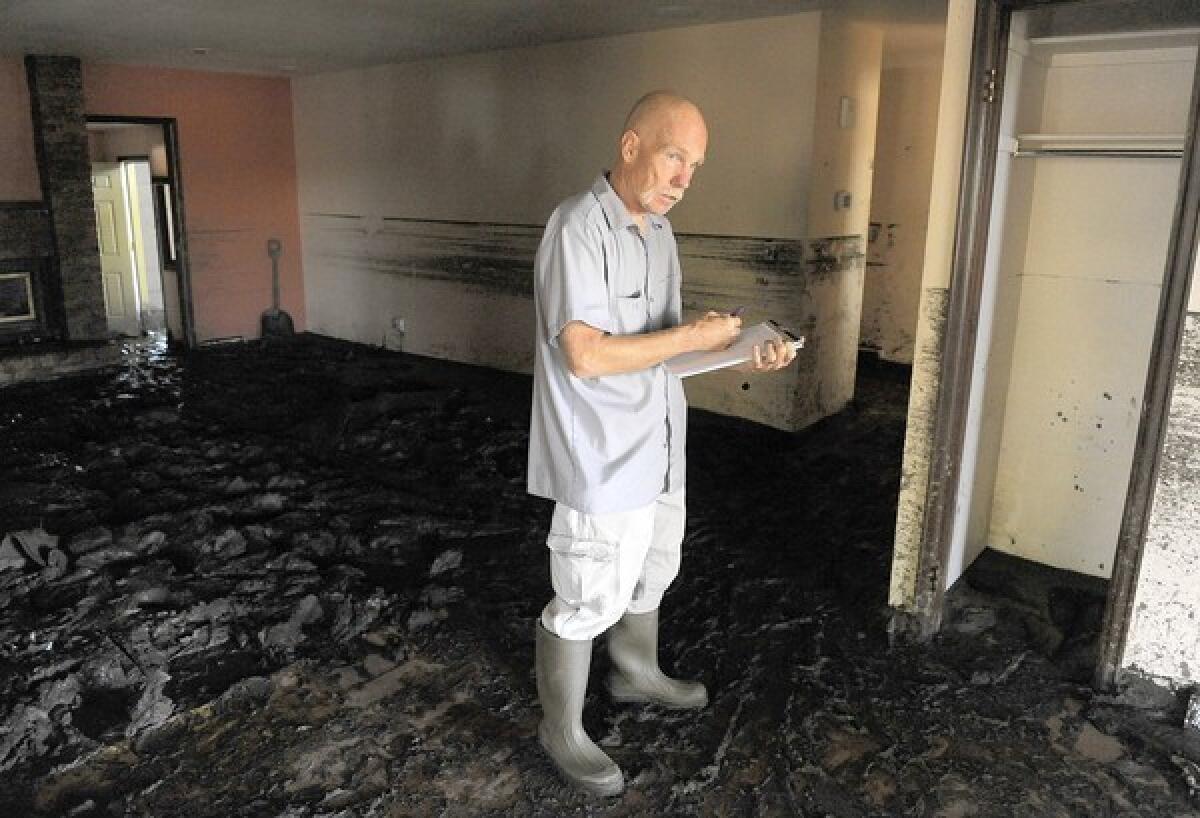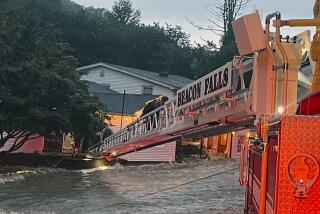Colorado’s problem turns from water to sludge

- Share via
EVANS, Colo. — The panicked escapes that took place in this riverside town last week were worth it: The trailer parks that frame the shoreline of the swollen South Platte now sit smashed and throttled by mud.
And not just any mud. When the flood claimed the nearby wastewater treatment plant too, officials and residents worried that the deluged edges of Evans had turned into a toxic open sewer.
“In our living room, there’s 6 to 8 inches of pure, black mud,” said Karen Kesterson, 68. “You just kind of slide around in it.”
Colorado’s epic rains brought more than just broken timber and broken homes. All across this state, from isolated mountain communities to low-lying suburban ones, the still-receding floodwaters carried tons of eroded mud and densely packed silt and deposited them onto residential properties.
Evans, just south of Greeley, was simply bearing witness to basic physics — which communities in eastern Colorado and Nebraska are now experiencing in a brutal way: Water goes downhill, sometimes carrying toxins with it.
The lingering magnitude of the disaster is staggering: By midweek, 17 counties in Colorado had been inundated. The floodwaters continued hurtling eastward, toward Deuel, Keith and Lincoln counties in Nebraska, which received flood warnings Wednesday.
“This water, the water we have here, started up in the mountains, so we have urban runoff, which could include fertilizer and agriculture runoff, which could include manure,” said Jennifer Finch, a spokeswoman for Weld County, where Evans is located. “That water has picked up a lot of stuff along the way, and sewage as well.”
Six Colorado residents were confirmed dead and 300 others remained missing after the equivalent of nearly a year’s worth of moisture fell in the course of several days along the eastern edge of the Rocky Mountains. Hundreds of people are still in the flood zone, but many continued to stay in their homes despite rescuers’ pleas to leave.
Among the thousands who evacuated, 484 remained scattered among shelters across the state.
Pete Alvarez, 53, and his mother, Susan, 72, were among them, bickering gently in the shade of the Greeley Recreation Center, which, unlike the other evacuation center in Evans, had the luxury of still-working toilets.
On Thursday night, Pete Alvarez had seen the police emergency lights atop an embankment overlooking the South Platte River, so he thought he would climb up the levee and take a look at the water. The water was frighteningly high, and he told his mother so.
“I think it’s gonna come over the top,” he told her. She disagreed, and, too tired to fight about it, he went to sleep.
“I should have listened to myself,” he would recall later.
The next morning, Friday, he would awake to shouting and car horns and a river that was galloping toward their trailer park.
“Let’s go! Let’s go right now!” Susan Alvarez’s partner, Manuel Trujillo, told her.
By the time she grabbed her purse and her medications and made it down the stairs of her 70-foot single-wide, the water was at her waist.
Pete Alvarez took off running for his truck, a ’93 Chevy, which had begun rocking in the water. He struggled to pry open the door against even a few inches of water.
Trujillo headed for his own truck with Susan, but hurt his arm trying to open the door against the swift current.
“Dear God, look at the water, Manuel!” she told him. “I don’t know how to swim!”
There was no siren, they recalled; just the shouts of their neighbors.
As the trucks splashed out of the rising floodwaters, a woman at the edge of the trailer park leapt in front of Pete Alvarez’s truck, waving her arms. “Get in! Get in!” he called to her.
“Take me back to my truck!” she said, gesturing back at the flooded park. Alvarez was not heading back, so she refused to get in. And when he last saw the woman, she was wading back into the park, despite the rising water.
“I don’t know what happened to her,” he said.
There was one other visible byproduct of all that water and sludge: A mass of crickets and other bugs were swarming at the town’s flooded baseball diamonds. At a ranch next door, Laura Speer, 43, was turning five of her mares loose with her cattle and releasing her 10 doves.
Kesterson, whose living room at the trailer park had filled with mud, talked about not having been able to take her two parakeets, Moe and Curly, with her as she evacuated. She had set their cage up on a cupboard as her trailer flooded, as officials rescued her. Two days later, the birds were found alive, just above a layer of grime marking where the waters had risen.
Lucky.
Times staff writer Michael Muskal in Los Angeles contributed to this report.
More to Read
Sign up for Essential California
The most important California stories and recommendations in your inbox every morning.
You may occasionally receive promotional content from the Los Angeles Times.











